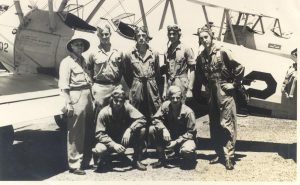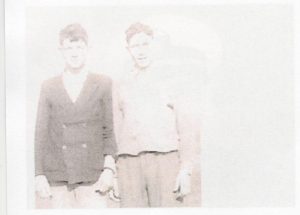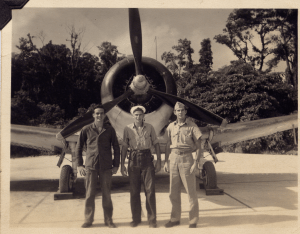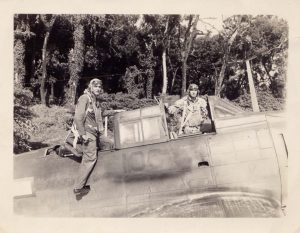WORLD WAR II VETERANS CONCORDIA PARISH LOUISIANA
CHINESE AMERICAN COMPOSITE WING
RICHARD C. DAGGETT
CHINA
28th Squadron, Third Fighter Group Captain Pilot P-40
Combat Experience———————-Shot Down on 31st Combat Mission
Awards: Air Medal
Purple Heart
I was born in Medford, Massachusetts, child of Mr. & Mrs. Fred Daggett. On December 7, 1941, “Pearl Harbor Day” I was a student at Colgate University. At Christmas time I packed my bags and went home to enlist in the Air Force. I was told that I would have to have two years college or the equivalent. I took the exam and luckily passed the requirements for the Cadet Corps.
After a weeks absence, I was sent to Montgomery, Alabama. So many had signed up that they were overcrowded, but tents took care of the overflow. In pre-flight school we were hurried through as we learned about engines, plane recognition, Morse code and what the Cadets did at West Point. We were issued rifles and gear, and on Sundays we marched in parades. When we went from one class to another, we jogged in formation.
From there we went to Primary Flying School in North Carolina. Our studies were accelerated and we began flying PT-17s, a bi-plane, covered with canvas, with a 220 horsepower motor. I soloed in 7 or 8 hours. Some washed out and were sent to bombardier or navigational schools.
Next, I was sent to Bainbridge, Georgia for Basic Training. We flew the B-13, with a 450 horsepower motor. It was called the Voltaire Vibrator, because it vibrated so badly. We did instrument flying covered with a hood. You had to do a check ride with a regular pilot, behind you, also under the hood. I did not do something quite right, so he took the stick, and banged my knees back and forth. This provoked me, so I banged his knees back and forth. This was dangerous, because he was an officer and I was just a cadet, but when we landed, he smiled and said, “I guess you will do all right.”
From there I went to Advanced Flying School at Moultrie, Georgia. We flew AT-6s which had larger engines, retractable landing gear and other features. There I earned my wings and as a Second Lieutenant, was given a leave. I was “ A Yankee from Up North” so I was sent to Harding Field at Baton Rouge. I was assigned to the 54th Fighter Group, 56th Squadron, a unit just returned from Alaska where they were flying P39s. At the time, it was sad to me that when we finished training, I was kept on as an instructor. Al my buddies went to Europe to fly P-51s.
I went to Hardng Field by train to New Orleans, and then by bus to Baton Rouge. They let service men on the bus first. After I was seated, two girls got on the bus and sat right behind me. After a stop in Gonzales, I started a conversation with the girls, mostly with one. I did something I had never done in my life. I asked for her name and telephone number. Her name was Eula Routh Wurster. She was a Coed at LSU. When we got settled in the Bachelor Officers Quarters, I called and asked for a date. The next night, the same story. Finally, she consented to an afternoon date with me. Something must have clicked because we started going pretty steady. I flew P-40s andP-51s in the daytime and we danced at night.
Our Group was moved to Bartow, Florida. I missed Routh very much, called her on the telephone at her home in Jonesville and proposed. This is a special story. Jonesville had an old telephone system with operators, who would take your call and then ring the number and connect you with the person you were calling. That night, the system was not working. I had to tell the operator what I wanted. In turn, she would tell Routh, get her reply, and repeat it to me. I was in that telephone booth for an hour, and the sweat was pouring off me. My buddy who was outside kept knocking on the phone booth, asking what was going on. Routh finally accepted my proposal. Routh and her sister came by train to Jacksonville, Florida, where they had to sit and wait for us. I told her I had a car. My buddy and I went AWOL to go get them and bring them to the hotel at Bartow. We were married on August 22, 1943.
We stayed in Florida until I shipped out in February 1944. A Major and I went to Goldsboro, North Carolina, enroute overseas. We left New York City on two baby flattops. I was on the Mission Bay. We traveled, with an escort of Canadian Destroyers, for more than forty days. We went on a zig-zag course, not knowing where we were headed. When we finally crossed the equator, we knew we were not going to Europe. We went around the coast of Africa and finally got to Cape Town. We even had dinner with some of the people there Then we went to Madascar and anchored. The harbor was full of the ships that had been destroyed. We went on to Karachi, Pakistan.
We were scheduled to fly over the Hump into Kunming. It was the monsoon season, and up in the Burma way, the weather was so bad that we had to spend two or three weeks waiting. Then we flew over the Hump in a C-47, over some of the lower mountains, not the highest one. It was rough terrain. I have never seen anything like it. I think that recently they have found a B-24 that crashed there. At Kunming I was assigned to the 5th Fighter Group, Chinese-American Composite Wing (half Chinese, half American). General Claire Chennault had a vision of training the Chinese in combat. These boys had been in the US a couple of years and sent back to China to learn combat. On each mission there were two American pilots and two Chinese pilots. This would be two elements of two planes each, a flight of four planes. I was first sent from Kunming to Qualing, a place the Japanese were about to take. That is the last time I saw my foot-locker. They flew us out to a place called Anshun, the base for the Chinese-American Composite Wing.
There I was assigned to the 28th Fighter Squadron,3rd Fighter Group, Chinese-American Composite Wing. The Major who was Squadron Commander, and happened to be at Luanchuan at the time, was going to fly me back to the base at Anshun. This P-40 (a single seater plane) had a little jump seat behind the pilot. You had to climb in through the baggage compartment, with a little place to sit, but no parachute. We finally got into the 28th Fighter Squadron.
Our group had B-25 bombers which we escorted. Most of our own missions were strafing. Of course, at times we were jumped by Zeros and had dog-fights. We had 650 caliber machine guns, three on each wing, controlled electrically. All six fired at the same time. Ammunition was stored in the wings. We had tracer bullets, smoke going out, incendiaries and regular shells. If we ran into tanks, we had the right ammunition. Every fifth shell was a tracer, to show us where we were shooting.
We were stationed in Central China at a little field surrounded by mountains on three sides. This meant that we had to take off and land in one direction. Instead of revetments, they had carved out the side of one mountain and made a big cave. At nighttime, we would taxi our planes into the cave to protect them from Japanese bombing. The Japanese would often send over a single bomber. We would stay in our sacks until the first bomb exploded and then head for the trenches. The Japanese sometimes dropped what they called banana bombs. These were small bombs in a big canister. When the canister fell, it would open up and scatter the little bombs about the field. Often they would fail to explode, and we would have live bombs across the field. The Chinese who controlled our area, would clear the field so that we could taxi and take-off.
Our missions on ground patrol were the most dangerous of all, because when you strafed troops or convoys, you had everyone shooting at you from close range. When you were at altitude in combat, you had one or two planes to deal with. Chennault had a pattern for flying that was effective. We flew in elements of two. One was the leader and the other the wing man. The leader did most of the shooting and the wing man’s job was to protect the tail of the leader. If the wing man was attacked, the leader had to drop back and protect him. We had self sealing gas tanks, armor plates on the cockpit and a windshield about four inches thick. The zeros did not have this extra weight and were more maneuverable. They could turn inside and shoot us down, so our technique was to dive down on them, shoot and keep going.
We also did river sweeps on the Yangtze not far from Hangzhou. We would shoot up sampans and everything that moved on the river, knowing that it was Japanese, not Chinese. One day on a river sweep, we did not see any sampans and started to fly to another area. Then a Chinese up ahead began to jabber in Chinese saying up ahead was a Japanese transport. The Chinese took after the transport and the two Americans followed. As we got closer, the Chinese began to wiggle his wings, as if friendly. A door flew out of the airplane and four people jumped. They tumbled and tumbled, three hitting in the water and the fourth apparently on dry land. They were not wearing parachutes.
We knew General Chennault was the in command, but we never g
ot to see him. Everything was flown in over the Hump. Gasoline came in drums, stored there, and rolled out to the plane for fueling. Wehad only one old truck which was a charcoal burner. There were some roads, but everyone walked. If you went into town, you had Chinese guards with you. Everything was polluted. If a pig was killed, it was hung outside and covered with flies. Kids follower you around saying “Ding How”. Thew knew we were there to help them. The Chinese did not have an Air Force when the Japanese invaded Manchuria in 1932.
The Chinese weren’t very tall. They did not have to shave. Some of the old men had little goatees that they had been growing all their lives. They had different classes. The coolies were the laborers.
We had a medical contingency with us, but the doctor was a veterinarian. All supplies were flown over the Hump. We had Chinese food and most of us had dysentery most of the time. It was very primitive. One difficult thing was trying to get mail in. We got mail only about every three months. If they sent cookies, they were hard as nails. During the winter, the weather was so bad we could not fly. Sometimes we did not have gasoline. Maps weren’t very accurate. It was lonely and pretty difficult, especially for the enlisted men. There was no place to spend money so most of it was sent home. Gaming took the rest of it quickly.
We only had 8 or 10 pilots. We had a maintenance officer and an intelligence officer. The rest were enlisted men. Spare parts were hard to come by. They used a lot of wire and substitute items to keep things together.
My first mission was interesting. As a bomber escort, we were flying top cover for B-25s. I think that every time you went into combat, you were scared to death. You overcame it as soon as you got into action. To me it was exciting, like playing a football game. On this mission I had my tail wheel shot off and I didn’t even know it, We had no fire extinguishing equipment, just a grass field to land on. The larger bases had thousands of coolies bringing in rock and making a composite strip (All hand labor).
Another mission we went on was led by a Major (later a Lt.Col.)
We left early, before daylight and saw a Japanese convoy. A motorcycle was leading the convoy. I literally saw him blow the rider off the motorcycle. We set everything afire and destroyed every vehicle. It must be a terrifying experience to have an airplane come in firing and strafing. There is no place to go except under a truck (if it is not burning). I killed a lot of people, but realized that was my job. The only thing that bothered me was to think back that it was someone’s son or husband.
I was shot down. We were on a mission and missed the factory. So we went back the next day, my 31st mission. We dive-bombed and strafed. As I pulled off the target, my airplane shuddered, so I knew that I was hit. As I climbed up, I was trailing smoke and knew that I would have to bail out. I rolled the canopy back and squatted on the seat behind the windshield. I turned the airplane with my left hand and was flying with the fingers of my left hand on the stick. I kept thinking, “How did they tell us how to get out of here?” When I was in the fifth grade we had to memorize the 23rd Psalm. I began to recite it, “Yea, though I walk through the valley of the shadow of death—” and became very calm. All of a sudden the airplane stalled, rolled over on its wing and I fell out. I was so low that my chute did not open, and I just fell between two wooded areas.
This was August 29,1944, a year and one week after I was married. My leg was injured, but I got out of my chute and threw it into the plane, which was burning. I took out my survival kit and was wearing my hip holster with my 45 caliber pistol. I saw someone coming over the hill, waving his arms. I realized that he was not trying to kill me if he was waving his arms. He came up and when he saw that I could not walk, he took me piggyback, into the woods. As I said earlier, these Chinese men were not very large.
Another grabbed me and carried me for a while. The Japanese were chasing us and my rescuers were exhausted. They set me on the ground and went in different directions. Finally, they came back with two poles. They put me on the poles, but my arms were so tired and weak that I fell off. They tied their shirts on the poles, and we traveled much faster.
At night we got to this little town, maybe the one we had bombed. I don’t know. They took me into a smoke filled room, possibly opium. It was filled with tough-looking Chinese men. They eyeballed me. I was completely at their mercy and did not know what to expect. We spent the night and just before daylight, they made a kind of stretcher and we took off. We came to a place and stayed there all day. We began to travel at night. This was all farms and farmhouses. At one place, they took the door off the farmhouse and placed it on saw horses for my bed.
We continued to travel at night. We had to live off the land and would go a day or two without eating. At one farmhouse, there was no one there, but there were several bowls of rice on the table. That pleased us and we started eating with our hands. Then, I noticed the rice was moving. It was filled with maggots, but we were so hungry that we did not stop eating. At these houses, they would bring their cattle, hogs and chickens in at night. In the towns, they did have plenty of pigs and chickens We even had some of their ten year old eggs. They were packed in clay and placed on a shelf. They didn’t look like eggs. The yolk was black and the white was transparent. They didn’t taste like eggs. In some cases we found noodles in the sheds.
One day, it was raining pretty hard, and they had me covered with a tarp. Two coolies were carrying me. The way they carried me was to put the bars (poles) on their shoulders, so I jogged up and down as they walked. Three guerrillas were with me. We found a good-sized shed, with boards running vertically, spaced about an inch apart for ventilation. We thought we would be able to get out of the rain. When we opened the door we found the shed packed with Chinese soldiers. They managed a space along the edge for me and I spent the night there. The soldiers were packed in so tight that they slept standing up. They swayed in unison all night. They coughed, but they had no medicine. All were eating garlic.
We kept moving from one place to another. One of my rescuers decided I needed a shave. At one place, he found an old straight razor and tried. The razor was so dull that the result was failure. Later, after no bath in three weeks, I tried to gesture that I wanted a bath. I knew a few words of Chinese, but they knew no English. I had to depend on them completely.
The first guerrilla who found me had his hand shot between the thumb and forefinger. This is what they did if they caught you stealing. I had him undo his bandage. He had a rag stuck into the wound. In my jungle kit, I had some sulfur and bandage. Later, he showed me that it was healing.
We went into one farmyard and found a big tub. After heating some water, with only men around, I climbed in the tub. Then came the women and children to see what an American looked like. I was so glad to have a hot bath that I could not be embarrassed. Then we got on a sampan and went down the river. One night, we camped with the Chinese Army who were opening a way for us to get through.
One morning the coolies carrying me were running. We came to some rice paddies and they stopped to rest. They were exhausted. One pointed up. The Japanese were coming. They started running along the river dike. The Japanese were shooting at us. The man in front slipped down and I went sailing out into the water. Bullets were kicking mud up all around us. We stopped at the first mound and huddled there. I did not even have a pocket knife. Each of the three guerrillas carried a pistol. After about an hour, we moved to another mound and finally worked our way out of there.
The most exciting time to me, was when they carried me over the mountains. We went up goat trails and they were still carrying me on their shoulders. I could look down and see the river far below. I looked only one time. We had traveled 28 days and they had not put a splint on my leg. It had just turned black from the injuries. We reached a place called Hoko. A plane carried me to Chenghai to the hospital. The Americans paid the Chinese $10,000 for each pilot brought in, so we can understand why the guerrillas worked so hard to save me. We had a lot of pilots shot down on our missions. One friend was captured by outlaws, who tried to trade him and then killed him.
I flew other missions, and later was sent back to Karachi, Pakistan to train replacement pilots. I came back to the States after the war was over in Europe.
Me and my Flying Tiger “PEEP & WEEP” in better days.






